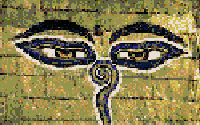
MEDITATION
Also a practice rarely used in the west, meditation has nothing but
positive appelations for mental health. Dhyana is the word for
meditation, and there are numerous dhyana deities who exist as
the qualities of this practice. Meditation is at the center of
nearly every eastern mystical practice. Buddha developed his
teachings as a result of a legendary and lengthy mediation where he
chose to sit and not cease until he had reached his conclusions.
One of the first benefits of meditation is a rest for the mind.
Psychologists are just beginning to understand that common ailments
such as depression and anxiety are actually the result of an
overabundance of mental energy. This results in sleeplessness and
inactivity. The mind is constantly active, day in day out, while
awake it processes information, and while sleeping it solves
problems through dreaming. Besides the mind, every organ in the
body reduces its activity during sleep. So when does the mind rest?
According to eastern tradition, the only way to attain this rest is
by actually sitting down and doing nothing. Not watching TV or
perusing a book, but by actively pursuing the goal of voiding
[sunyata] the mind. This is actually quite difficult, and is
considered the first stage of adept skill. One seeks the goal of
reducing the presence of personal identity, or ego [ahamkara], and
to push away, gently, each and every thought that enters the mind.
There are several ajana [postures] that one may assume, the most
famous being the lotus.
Try it. Sit with your legs crossed, making sure there is no
pressure on either ankle. Sit up straight, and practice the
complete breath. Then, rest your eyes and purposely think nothing.
Each time you experience thought, gently push it away by focusing on
the rythm of your breathing. The first thing a person will
encounter is how much noise is actually present in one's head, and
how difficult it is to simply think nothing. If the back aches, try
prostrating yourself forward in the sitting position, stretching the
lower back. Done just once for more than a half hour, the results
are self evident. I believe each person owes it to themselves just
to try this. An hour every day, and language comes out more
concisely afterwards, the days seem to rush by less quickly, and
arbitrary cravings subside.
One Tantric writes: "When the mind goes to rest, the bounds of the
body are destroyed. And when the flavour of the innate pours forth,
their is neither outcaste nor priest [brahmin]."
One begins to realise an unknown part of themselves, a clue towards
their own Total Nature [prakrti]. There is also a movement towards
the divine state of saccidananda, three words compounded to form
'existance consciousness bliss'. The awareness of the self is the
key to higher stages of meditation. This illusory body is divided
into stages of skill by the Tantrics:
1. Symbolic
2. Apparitional
3. Dream-like
4. Intermediate stage after death.
5. Inner radiance
6. Emanation
7. Pristine cognition.
"When the mind moves, its knowledge ceases to be true as it deviates
from itself; it is then neither eternal, nor blissful, nor
self-seeking, nor free from defilement; on the contrary it burns,
suffers pain, it becomes subject to decay and change... When the
mind remains in and with itself and has no rising of thought it is
the great light Prajna... some things are perceived while others
remain unperceived; but the mind itself stands outside perception
and for this reason it universally illumines the world."